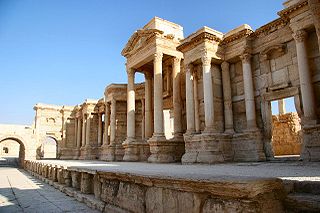Related Research Articles

Year 637 (DCXXXVII) was a common year starting on Wednesday of the Julian calendar. The denomination 637 for this year has been used since the early medieval period, when the Anno Domini calendar era became the prevalent method in Europe for naming years.

Uthman ibn Affan was the third caliph, ruling from 644 until his assassination in 656. Uthman, a second cousin, son-in-law, and notable companion of the Islamic prophet Muhammad, played a major role in early Islamic history. During his reign as caliph, he was known for ordering the official compilation of the standardized version of the Quran that is still being used today.

The Muslim conquest of Persia, also called the Muslim conquest of Iran, the Arab conquest of Persia, or the Arab conquest of Iran, was a major military campaign undertaken by the Rashidun Caliphate between 632 and 654. As part of the early Muslim conquests, which had begun under Muhammad in 622, it led to the fall of the Sasanian Empire and the eventual decline of Zoroastrianism, which had been predominant throughout Persia as the nation's official religion. The persecution of Zoroastrians by the early Muslims during and after this conflict prompted many of them to flee eastward to India, where they were granted refuge by various kings.
The Muhajirun were the converts to Islam and the Islamic prophet Muhammad's advisors and relatives, who emigrated from Mecca to Medina, the event is known in Islam as the Hijra. The early Muslims from Medina are called the Ansar ("helpers").
Al-Ala al-Hadrami was an early Muslim commander and the tax collector of Bahrayn under the Islamic prophet Muhammad in c. 631–632 and Bahrayn's governor in 632–636 and 637–638 under caliphs Abu Bakr and Umar. Under Abu Bakr, al-Ala suppressed a rebellion by a scion of the pro-Sasanian Lakhmid dynasty as part of the Ridda wars. Under Umar, he launched naval expeditions against the Sasanians, the last of which ended in disaster for the Arabs and was the cause of his dismissal. He was last appointed governor of Basra but died on his way there to assume office.

The Muslim conquest of the Levant, or Arab conquest of Syria, was a 634–638 CE invasion of Byzantine Syria by the Rashidun Caliphate. A part of the wider Arab-Byzantine Wars, the Levant was brought under Arab Muslim rule and developed into the provincial region of Bilad al-Sham. Clashes between the Arabs and Byzantines on the southern Levantine borders of the Byzantine Empire had occurred during the lifetime of Muhammad, with the Battle of Muʿtah in 629 CE. However, the actual conquest did not begin until 634, two years after Muhammad's death. It was led by the first two Rashidun caliphs who succeeded Muhammad: Abu Bakr and Umar ibn al-Khattab. During this time, Khalid ibn al-Walid was the most important leader of the Rashidun army.

Umar was the second Rashidun Caliph and reigned during 634–644. Umar's caliphate is notable for its vast conquests. Aided by brilliant field commanders, he was able to incorporate present-day Iraq, Iran, Azerbaijan, Armenia, Georgia, Syria, Jordan, Palestine, Lebanon, Egypt, and parts of Afghanistan, Turkmenistan and south western Pakistan into the Caliphate. During his reign, the Byzantines lost more than three fourths of their territory and in Persia, and Umar was the king (ruler) of the Sassanid Empire before it ceased to exist.

Uthman, the third Rashidun caliph from 644 to 656, was assassinated at the end of a siege upon his house in 656. Initially a protest, the siege escalated following the death of a protester. The protesters-turned-rebels had demanded a new caliph, but Uthman refused and on 17 June 656, as his house was set alight, some protestors were able to jump to the back of his house, where they found him reading the Qur'an. They gave him a blow over the head and pierced him through his stomach.

The Rashidun Caliphate was the first caliphate to succeed the Islamic prophet Muhammad. It was ruled by the first four successive caliphs of Muhammad after his death in 632 CE. During its existence, the empire was the most powerful economic, cultural, and military force in West Asia and Northeast Africa.
Abū ʿAbd al-Raḥmān ʿAbd Allāh ibn ʿĀmir ibn Kurayz was a Rashidun politician and general, he served as the governor of Basra from 647 to 656 AD during the reign of Rashidun Caliph Uthman ibn Affan. Through his father, he was a cousin of the Caliph. He is renowned for his administrative and military prowess, particularly for his successful campaigns of reconquest and pacification in the former territories of the Sasanian Empire, in what is now present-day Iran and Afghanistan.
The Rashidun army was the core of the Rashidun Caliphate's armed forces during the early Muslim conquests in the 7th century. The army is reported to have maintained a high level of discipline, strategic prowess and organization, granting them successive victories in their various campaigns.

The Battle of Rasil was fought between the Rashidun Caliphate and the Rai kingdom ruled by Raja Rasil in early 644. It was the first encounter of the Rashidun Caliphate in the Indian subcontinent. The exact location of the battle is not known, but historians suggest it was fought on the western bank of the River Indus.
The Battle of Jalula was fought between the Sasanian Empire and the Rashidun Caliphate soon after conquest of Ctesiphon.

Amr ibn al-As ibn Wa'il al-Sahmi was the Arab commander who led the Muslim conquest of Egypt and served as its governor in 640–646 and 658–664. The son of a wealthy Qurayshite, Amr embraced Islam in c. 629 and was assigned important roles in the nascent Muslim community by the Islamic prophet Muhammad. The first caliph Abu Bakr appointed Amr as a commander of the conquest of Syria. He conquered most of Palestine, to which he was appointed governor, and helped lead the Arabs to decisive victories over the Byzantines at the battles of Ajnadayn and the Yarmuk in 634 and 636.
Arfajah ibn Harthama al-Bariqi was a companion of the Islamic prophet Muhammad. He was a member of the Azd branch of the Bariq clan that inhabited Southwestern Arabia.

The Arab conquest of Pars took place from 638/9 to 650/1, and ended with subjugation of the Sasanian province of Pars, also known as Fars or Persis, to the Rashidun Caliphate under Umar.
Abu al-A'war Amr ibn Sufyan ibn Abd Shams al-Sulami, identified with the Abulathar or Aboubacharos of the Byzantine sources, was an Arab admiral and general, serving in the armies of the Rashidun caliphs Abu Bakr, Umar and Uthman rejecting the fourth Rashidun caliph Ali, instead serving Umayyad caliph Mu'awiya I.

Pars was a Sasanian province in Late Antiquity, which almost corresponded to the present-day province of Fars. The province bordered Khuzestan in the west, Kirman in the east, Spahan in the north, and Mazun in the south.

The Arab Empire maintained and expanded a wide trade network across parts of Asia, Africa and Europe. This helped establish the Arab Empire as the world's leading economic power throughout the 8th–13th centuries according to the political scientist John M. Hobson. It is commonly believed that Mu‘awiya Ibn Abi Sufyan was the first planner and establisher of the Islamic navy.
References
- ↑ Peter Crawford (2014), "The War of the Three Gods: Romans, Persians and the Rise of Islam", Skyhorse Publishing. ISBN 978-1629145129.
- ↑ Hugh N. Kennedy (2007), "The great Arab conquests", Da Capo Press. ISBN 978-0306815850.